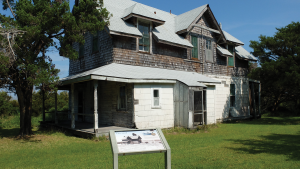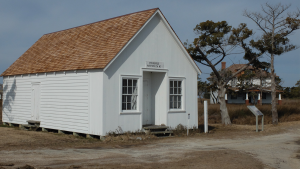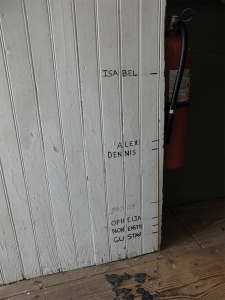Budgeting for Climate Change
This post was written by Brittany Sweeney, College of Natural Resources, NC State University, for CNR News, 3 Feb 17.
In a time of budget cuts, aging historic sites, and climate change, who decides what projects receive updates and restorations and which ones don’t? Dr. Erin Seekamp, Associate Professor in Parks, Recreation and Tourism Management and a Tourism Extension Specialist, and her team are developing a strategy template to identifying cultural resources and prioritize them for adaptive actions, beginning with historic coastal Carolina icons like the Cape Lookout Lighthouse on the Cape Lookout National Seashore (CALO) on the North Carolina Coast.
Currently there is no policy to help cultural resource managers differentiate between the relative significance and historic value of different historic buildings or cultural resources. All cultural resources listed on the National Register of Historic Places are considered equally important and valuable. Through Seekamp’s new process, resource managers will be able to calculate the resource’s value for ranking based on vulnerability to climate change, historical significance, importance to daily park operations and education potential.

“The National Park Service (NPS) is currently operating under policy guidance to focus climate adaptation efforts on the most vulnerable and the most significant cultural heritage assets; however, no transparent process exists for assessing trade-offs between protecting the most vulnerable assets and protecting the most historically valuable assets under budgetary constraints,” Seekamp said. “We addressed this policy implementation gap, by developing a co-production process with NPS personnel and other stakeholders using a decision analytic framework. We contextualized our discussions using a representative subset of buildings listed on the National Register of Historic Places located within two distinct historic districts on barrier islands at Cape Lookout National Seashore. We framed the problem as how to best manage the portfolio of buildings to maximize historical significance over a 30-year planning horizon.”
The pilot project at CALO, funded by the USGS SE Climate Science Center (SECSC), is significant because of nearly equal vulnerability of the historic buildings to climate change impacts on sea level rise, shoreline erosion and stronger hurricanes. Therefore, a process was needed to determine how to rate the cultural significance of the resources in Portsmouth Village and Cape Lookout Village that vary by visitor use, building condition, distinct history of human occupation and stakeholder value.
“The NPS is charged with protecting cultural and historical resources, and a recent report estimated more than $40 billion coastal assets, including park infrastructure, as well as historic and cultural resources, are at high risk of damage from sea-level rise,” Seekamp said. “Given that cultural resources hold diverse values and that any loss is permanent, transparency in decision-making is paramount, as it is unlikely that all cultural and historical resources can be preserved in perpetuity given budgetary constraints and that some adaptation options may alter the integrity of the resource.”

The key to the success of the CALO project was the close partnerships forged between researchers and National Park managers and other cultural resource stakeholders. Seekamp and her team worked closely with the CALO Park Superintendent and the Chief of Resources, NC State Historic Preservation Office, and NPS personnel (including members of the Climate Change Response Program, Technical Preservation Services, Sustainable Operations and Climate Change Branch, South Atlantic Landscape Conservation Cooperative and Southeast Regional Office).
Additional vetting of the cultural significance metrics will be occurring this spring with other historic preservation stakeholders from across the country. A partnership with researchers from the Program for Study of Developed Shorelines at Western Carolina University allowed Seekamp’s team to integrate the NPS current vulnerability assessment data into the decision support tool. USGS decision analysts, Mitch Eaton and Max Post van der Burg, created the prototype model that integrates significance, vulnerability, and budget constraints.
“One of the most interesting things we learned was that not only was the significance of buildings important for decision-making but also their use potential,” Seekamp said. “The NPS values investment in buildings that not only are historically significant but that can also be used for park operations, visitor access, potential third party use like concessions, historical interpretation, and/or scientific study.”

Seekamp was also surprised by what she calls the “co-production of knowledge” approach used to develop the new process. “We were not expecting the considerable amount of co-learning and alternative ways of thinking during the structured decision-making workshops we held, particularly given the level of expertise of our participants,” she said. “This openness not only demonstrates that linking science with negotiation can help bridge the gap between policy and practices but also the need for these important conversations about cultural resource management under climate change.”
The next step for Seekamp is to expand the new structured decision making process regionally nationally. She was recently award additional funding by the SECSC to refine the decision framework and the modeling tool, and develop a user-friendly, web-based data entry interface. To refine the framework, she is holding two additional workshops to elicit additional information from other State Historic Preservation Office personnel at their National Conference and other NPS personnel at the George Wright Society Conference. Although the CALO pilot project is now expected to conclude in September 2017, Seekamp is currently engaged in conversations with the NPS to test the model at other coastal parks.
Recently, the CALO project was included in the NPS report “Cultural Resources Climate Change Strategy” and was the most downloaded document from a government website, according to a Washington Post article. The USGS also featured Seekamp’s CALO project as a USGS Top Story.
- Categories:
